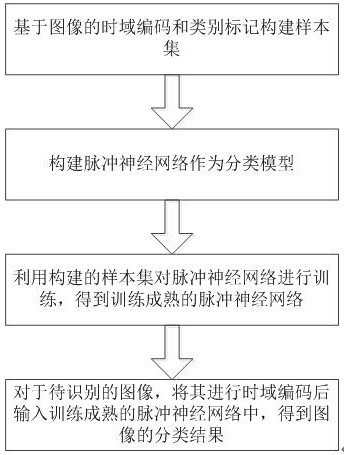Image classification method based on time domain coding and pulse neural network
A technology of spiking neural network and time-domain coding, which is applied in the field of image classification based on time-domain coding and spiking neural network, can solve the problems of difficult classification and recognition, time-consuming, and difficulty of gradient decreasing.
- Summary
- Abstract
- Description
- Claims
- Application Information
AI Technical Summary
Problems solved by technology
Method used
Image
Examples
Embodiment Construction
[0023] The technical solution of the present invention will be further described in detail below in conjunction with the accompanying drawings, but the protection scope of the present invention is not limited to the following description.
[0024] Such as figure 1 As shown, an image classification method based on temporal coding and spiking neural network, including the following steps:
[0025] S1. Constructing a sample set based on time-domain encoding and category labeling of images;
[0026] S2. Construct a spiking neural network as a classification model;
[0027] S3. Using the constructed sample set to train the spiking neural network to obtain a mature trained spiking neural network;
[0028] S4. For the image to be recognized, it is encoded in the time domain and then input into the well-trained spiking neural network to obtain the classification result of the image.
[0029] Wherein, the step S1 includes the following sub-steps:
[0030] S1. Collect multiple image...
PUM
 Login to View More
Login to View More Abstract
Description
Claims
Application Information
 Login to View More
Login to View More - R&D
- Intellectual Property
- Life Sciences
- Materials
- Tech Scout
- Unparalleled Data Quality
- Higher Quality Content
- 60% Fewer Hallucinations
Browse by: Latest US Patents, China's latest patents, Technical Efficacy Thesaurus, Application Domain, Technology Topic, Popular Technical Reports.
© 2025 PatSnap. All rights reserved.Legal|Privacy policy|Modern Slavery Act Transparency Statement|Sitemap|About US| Contact US: help@patsnap.com



